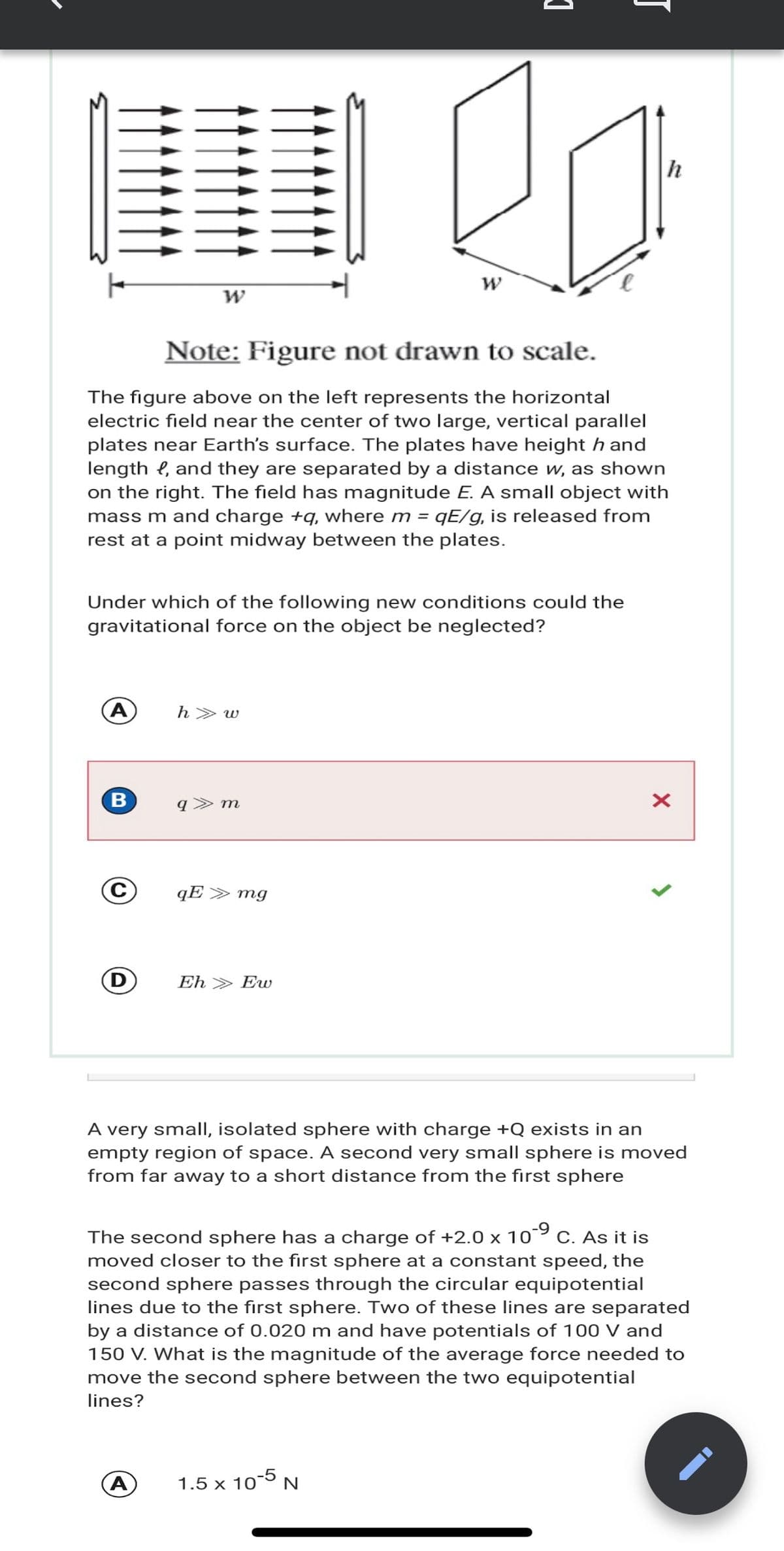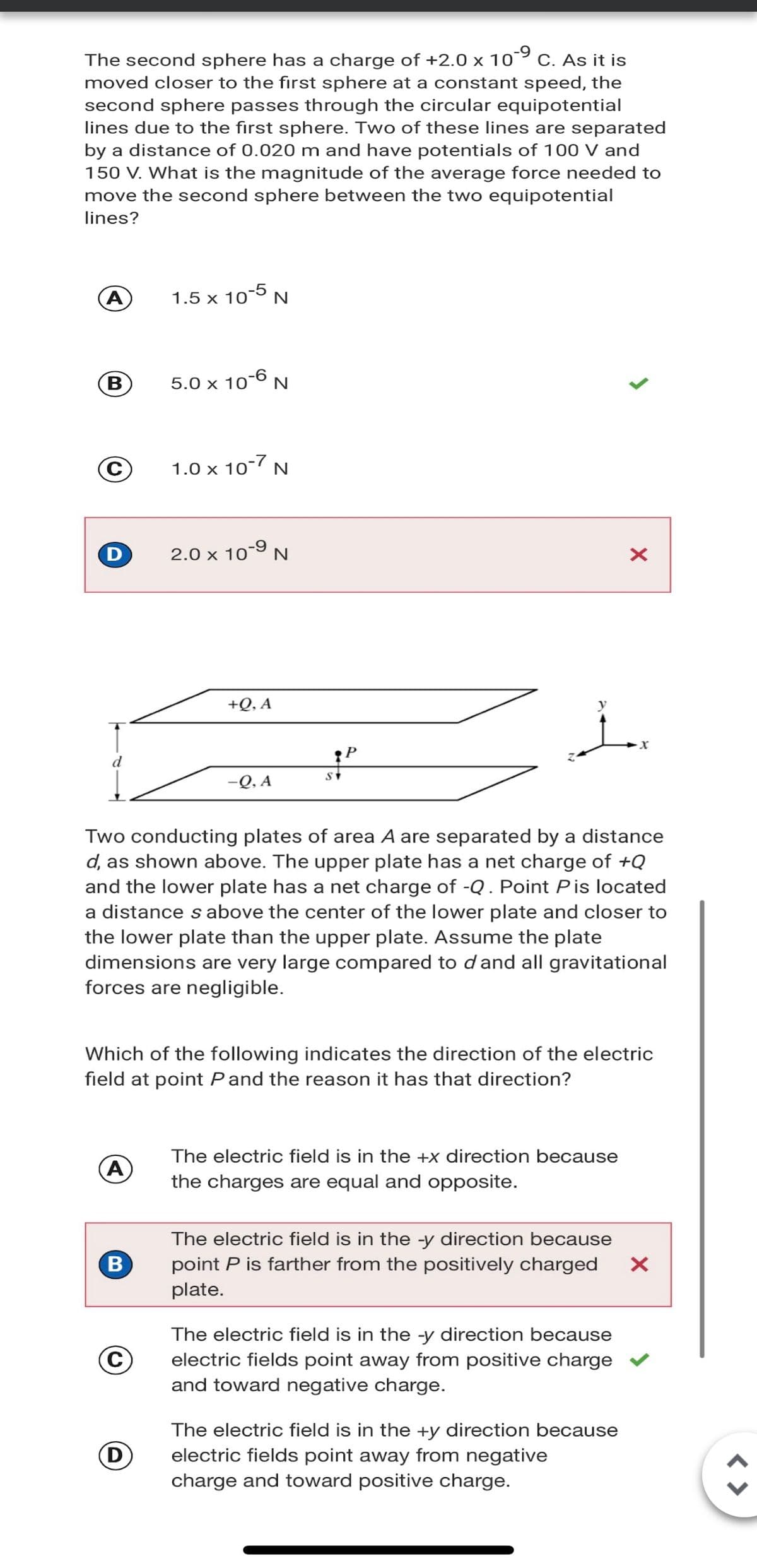Note: Figure not drawn to scale. The figure above on the left represents the horizontal electric field near the center of two large, vertical parallel plates near Earth's surface. The plates have height hand length , and they are separated by a distance w, as shown on the right. The field has magnitude E. A small object with mass m and charge +q, where m = qE/g, is released from rest at a point midway between the plates. (A) Under which of the following new conditions could the gravitational force on the object be neglected? B C W D h»w q> m qE> mg Eh ㅁ마 h W Ew X >
Note: Figure not drawn to scale. The figure above on the left represents the horizontal electric field near the center of two large, vertical parallel plates near Earth's surface. The plates have height hand length , and they are separated by a distance w, as shown on the right. The field has magnitude E. A small object with mass m and charge +q, where m = qE/g, is released from rest at a point midway between the plates. (A) Under which of the following new conditions could the gravitational force on the object be neglected? B C W D h»w q> m qE> mg Eh ㅁ마 h W Ew X >
Chapter7: Electricity
Section: Chapter Questions
Problem 33Q
Related questions
Concept explainers
Dielectric Constant Of Water
Water constitutes about 70% of earth. Some important distinguishing properties of water are high molar concentration, small dissociation constant and high dielectric constant.
Electrostatic Potential and Capacitance
An electrostatic force is a force caused by stationary electric charges /fields. The electrostatic force is caused by the transfer of electrons in conducting materials. Coulomb’s law determines the amount of force between two stationary, charged particles. The electric force is the force which acts between two stationary charges. It is also called Coulomb force.
Question
Can you help me understand why my answers were incorrect?

Transcribed Image Text:(Α
B
Under which of the following new conditions could the
gravitational force on the object be neglected?
C
W
Note: Figure not drawn to scale.
The figure above on the left represents the horizontal
electric field near the center of two large, vertical parallel
plates near Earth's surface. The plates have height hand
length, and they are separated by a distance w, as shown
on the right. The field has magnitude E. A small object with
mass m and charge +q, where m = qE/g, is released from
rest at a point midway between the plates.
D
h> w
A
q m
qE> mg
Eh Ew
1
J
ㅁ마
W
1.5 x 10-5
N
h
A very small, isolated sphere with charge +Q exists in an
empty region of space. A second very small sphere is moved
from far away to a short distance from the first sphere
X
The second sphere has a charge of +2.0 x 10 C. As it is
moved closer to the first sphere at a constant speed, the
second sphere passes through the circular equipotential
lines due to the first sphere. Two of these lines are separated
by a distance of 0.020 m and have potentials of 100 V and
150 V. What is the magnitude of the average force needed to
move the second sphere between the two equipotential
lines?
>

Transcribed Image Text:-9
The second sphere has a charge of +2.0 x 10 C. As it is
moved closer to the first sphere at a constant speed, the
second sphere passes through the circular equipotential
lines due to the first sphere. Two of these lines are separated
by a distance of 0.020 m and have potentials of 100 V and
150 V. What is the magnitude of the average force needed to
move the second sphere between the two equipotential
lines?
A
B
C
D
d
A
(Α
B
1.5 x 10-5 N
C
5.0 x 10-6 N
D
1.0 x 10-7 N
2.0 × 10-9 N
+Q, A
-Q, A
St
Two conducting plates of area A are separated by a distance
d, as shown above. The upper plate has a net charge of +Q
and the lower plate has a net charge of -Q. Point P is located
a distance s above the center of the lower plate and closer to
the lower plate than the upper plate. Assume the plate
dimensions are very large compared to d and all gravitational
forces are negligible.
P
Which of the following indicates the direction of the electric
field at point P and the reason it has that direction?
L
X
>
The electric field is in the +x direction because
the charges are equal and opposite.
X
The electric field is in the -y direction because
electric fields point away from positive charge
and toward negative charge.
The electric field is in the -y direction because
point P is farther from the positively charged X
plate.
The electric field is in the +y direction because
electric fields point away from negative
charge and toward positive charge.
<>
Expert Solution
This question has been solved!
Explore an expertly crafted, step-by-step solution for a thorough understanding of key concepts.
This is a popular solution!
Trending now
This is a popular solution!
Step by step
Solved in 3 steps

Knowledge Booster
Learn more about
Need a deep-dive on the concept behind this application? Look no further. Learn more about this topic, physics and related others by exploring similar questions and additional content below.Recommended textbooks for you



College Physics
Physics
ISBN:
9781305952300
Author:
Raymond A. Serway, Chris Vuille
Publisher:
Cengage Learning



College Physics
Physics
ISBN:
9781305952300
Author:
Raymond A. Serway, Chris Vuille
Publisher:
Cengage Learning

College Physics
Physics
ISBN:
9781285737027
Author:
Raymond A. Serway, Chris Vuille
Publisher:
Cengage Learning

College Physics
Physics
ISBN:
9781938168000
Author:
Paul Peter Urone, Roger Hinrichs
Publisher:
OpenStax College

Glencoe Physics: Principles and Problems, Student…
Physics
ISBN:
9780078807213
Author:
Paul W. Zitzewitz
Publisher:
Glencoe/McGraw-Hill